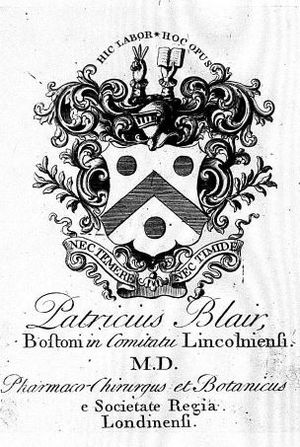Difference between revisions of "Patrick Blair ca.1680-1728"
m (David moved page Patrick Blair to Patrick Blair ca.1680-1728 without leaving a redirect) |
|||
| (One intermediate revision by the same user not shown) | |||
| Line 3: | Line 3: | ||
[[file:BlairPatrick.JPG|thumb|Patrick Blair's bookplate (British Museum Franks Collection 2748)]] | [[file:BlairPatrick.JPG|thumb|Patrick Blair's bookplate (British Museum Franks Collection 2748)]] | ||
====Biographical Note==== | ====Biographical Note==== | ||
| − | Born at [[place of birth::Lethendy, Perthsire]], son of [[family::George Blair]], [[occupation::farmer]]. He was occupation::apprentice|apprenticed]] to a [[occupation::surgeon]] before spending some years in the [[location::Netherlands]] 1694-97, practising surgery and studying [[subject::botany]]. By 1700 he was working as a [[occupation::surgeon]] in [[location::Dundee]], where he came to notice by skinning and exhibiting an elephant which died nearby. His account of the elephant's anatomy, published in the ''Philosophical Transactions'' in 1710, won him election to the fellowship of the [[organisations::Royal Society]] in 1712, in which year he was awarded the degree of MD from [[education::Aberdeen University]]. He travelled to [[location::London]] in 1713 where he met, among others, Sir [[associates::Hans Sloane]] and [[associates::James Petiver]]. He was caught up in the Jacobite rising of 1715 and only escaped execution through the intervention of Sloane and [[associates::Richard Mead]]. In 1720 he moved to [[location::Boston, Lincolnshire]] where he continued to practice medicine, and publish books and papers; his botanical catalogue ''Pharmaco-botanologia'' began to appear in 1723 but was unfinished at the time of his death. | + | Born at [[place of birth::Lethendy, Perthsire]], son of [[family::George Blair]], [[occupation::farmer]]. He was [[occupation::apprentice|apprenticed]] to a [[occupation::surgeon]] before spending some years in the [[location::Netherlands]] 1694-97, practising surgery and studying [[subject::botany]]. By 1700 he was working as a [[occupation::surgeon]] in [[location::Dundee]], where he came to notice by skinning and exhibiting an elephant which died nearby. His account of the elephant's anatomy, published in the ''Philosophical Transactions'' in 1710, won him election to the fellowship of the [[organisations::Royal Society]] in 1712, in which year he was awarded the degree of MD from [[education::Aberdeen University]]. He travelled to [[location::London]] in 1713 where he met, among others, Sir [[associates::Hans Sloane]] and [[associates::James Petiver]]. He was caught up in the Jacobite rising of 1715 and only escaped execution through the intervention of Sloane and [[associates::Richard Mead]]. In 1720 he moved to [[location::Boston, Lincolnshire]] where he continued to practice medicine, and publish books and papers; his botanical catalogue ''Pharmaco-botanologia'' began to appear in 1723 but was unfinished at the time of his death. |
====Books==== | ====Books==== | ||
Latest revision as of 23:33, 9 May 2021
Patrick BLAIR ca.1680-1728
Biographical Note
Born at Lethendy, Perthsire, son of George Blair, farmer. He was apprenticed to a surgeon before spending some years in the Netherlands 1694-97, practising surgery and studying botany. By 1700 he was working as a surgeon in Dundee, where he came to notice by skinning and exhibiting an elephant which died nearby. His account of the elephant's anatomy, published in the Philosophical Transactions in 1710, won him election to the fellowship of the Royal Society in 1712, in which year he was awarded the degree of MD from Aberdeen University. He travelled to London in 1713 where he met, among others, Sir Hans Sloane and James Petiver. He was caught up in the Jacobite rising of 1715 and only escaped execution through the intervention of Sloane and Richard Mead. In 1720 he moved to Boston, Lincolnshire where he continued to practice medicine, and publish books and papers; his botanical catalogue Pharmaco-botanologia began to appear in 1723 but was unfinished at the time of his death.
Books
Blair used an engraved armorial bookplate, made after 1720 when he was in Boston (Franks 2748); the extent and disposition of his library is not known.
Sources
- Gambier Howe, E. R. J. Franks bequest: catalogue of British and American book plates bequeathed to the ... British Museum. London, 1903.
- Guerrini, Anita. "Blair, Patrick (c. 1680–1728), botanist and surgeon." Oxford Dictionary of National Biography.
